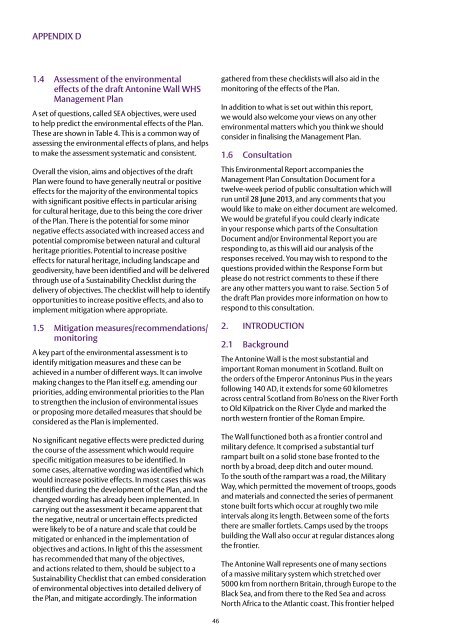The Antonine Wall Management Plan 2013-18 - Glasgow City Council
The Antonine Wall Management Plan 2013-18 - Glasgow City Council
The Antonine Wall Management Plan 2013-18 - Glasgow City Council
You also want an ePaper? Increase the reach of your titles
YUMPU automatically turns print PDFs into web optimized ePapers that Google loves.
appendix D<br />
1.4 Assessment of the environmental<br />
effects of the draft <strong>Antonine</strong> <strong>Wall</strong> WHS<br />
<strong>Management</strong> <strong>Plan</strong><br />
A set of questions, called SEA objectives, were used<br />
to help predict the environmental effects of the <strong>Plan</strong>.<br />
<strong>The</strong>se are shown in Table 4. This is a common way of<br />
assessing the environmental effects of plans, and helps<br />
to make the assessment systematic and consistent.<br />
Overall the vision, aims and objectives of the draft<br />
<strong>Plan</strong> were found to have generally neutral or positive<br />
effects for the majority of the environmental topics<br />
with significant positive effects in particular arising<br />
for cultural heritage, due to this being the core driver<br />
of the <strong>Plan</strong>. <strong>The</strong>re is the potential for some minor<br />
negative effects associated with increased access and<br />
potential compromise between natural and cultural<br />
heritage priorities. Potential to increase positive<br />
effects for natural heritage, including landscape and<br />
geodiversity, have been identified and will be delivered<br />
through use of a Sustainability Checklist during the<br />
delivery of objectives. <strong>The</strong> checklist will help to identify<br />
opportunities to increase positive effects, and also to<br />
implement mitigation where appropriate.<br />
1.5 Mitigation measures/recommendations/<br />
monitoring<br />
A key part of the environmental assessment is to<br />
identify mitigation measures and these can be<br />
achieved in a number of different ways. It can involve<br />
making changes to the <strong>Plan</strong> itself e.g. amending our<br />
priorities, adding environmental priorities to the <strong>Plan</strong><br />
to strengthen the inclusion of environmental issues<br />
or proposing more detailed measures that should be<br />
considered as the <strong>Plan</strong> is implemented.<br />
No significant negative effects were predicted during<br />
the course of the assessment which would require<br />
specific mitigation measures to be identified. In<br />
some cases, alternative wording was identified which<br />
would increase positive effects. In most cases this was<br />
identified during the development of the <strong>Plan</strong>, and the<br />
changed wording has already been implemented. In<br />
carrying out the assessment it became apparent that<br />
the negative, neutral or uncertain effects predicted<br />
were likely to be of a nature and scale that could be<br />
mitigated or enhanced in the implementation of<br />
objectives and actions. In light of this the assessment<br />
has recommended that many of the objectives,<br />
and actions related to them, should be subject to a<br />
Sustainability Checklist that can embed consideration<br />
of environmental objectives into detailed delivery of<br />
the <strong>Plan</strong>, and mitigate accordingly. <strong>The</strong> information<br />
gathered from these checklists will also aid in the<br />
monitoring of the effects of the <strong>Plan</strong>.<br />
In addition to what is set out within this report,<br />
we would also welcome your views on any other<br />
environmental matters which you think we should<br />
consider in finalising the <strong>Management</strong> <strong>Plan</strong>.<br />
1.6 Consultation<br />
This Environmental Report accompanies the<br />
<strong>Management</strong> <strong>Plan</strong> Consultation Document for a<br />
twelve-week period of public consultation which will<br />
run until 28 June <strong>2013</strong>, and any comments that you<br />
would like to make on either document are welcomed.<br />
We would be grateful if you could clearly indicate<br />
in your response which parts of the Consultation<br />
Document and/or Environmental Report you are<br />
responding to, as this will aid our analysis of the<br />
responses received. You may wish to respond to the<br />
questions provided within the Response Form but<br />
please do not restrict comments to these if there<br />
are any other matters you want to raise. Section 5 of<br />
the draft <strong>Plan</strong> provides more information on how to<br />
respond to this consultation.<br />
2. Introduction<br />
2.1 Background<br />
<strong>The</strong> <strong>Antonine</strong> <strong>Wall</strong> is the most substantial and<br />
important Roman monument in Scotland. Built on<br />
the orders of the Emperor Antoninus Pius in the years<br />
following 140 AD, it extends for some 60 kilometres<br />
across central Scotland from Bo’ness on the River Forth<br />
to Old Kilpatrick on the River Clyde and marked the<br />
north western frontier of the Roman Empire.<br />
<strong>The</strong> <strong>Wall</strong> functioned both as a frontier control and<br />
military defence. It comprised a substantial turf<br />
rampart built on a solid stone base fronted to the<br />
north by a broad, deep ditch and outer mound.<br />
To the south of the rampart was a road, the Military<br />
Way, which permitted the movement of troops, goods<br />
and materials and connected the series of permanent<br />
stone built forts which occur at roughly two mile<br />
intervals along its length. Between some of the forts<br />
there are smaller fortlets. Camps used by the troops<br />
building the <strong>Wall</strong> also occur at regular distances along<br />
the frontier.<br />
<strong>The</strong> <strong>Antonine</strong> <strong>Wall</strong> represents one of many sections<br />
of a massive military system which stretched over<br />
5000 km from northern Britain, through Europe to the<br />
Black Sea, and from there to the Red Sea and across<br />
North Africa to the Atlantic coast. This frontier helped<br />
46












![Elgin Cathedral Wedding Brochure [pdf, 544kb] - Historic Scotland](https://img.yumpu.com/22301571/1/190x151/elgin-cathedral-wedding-brochure-pdf-544kb-historic-scotland.jpg?quality=85)



